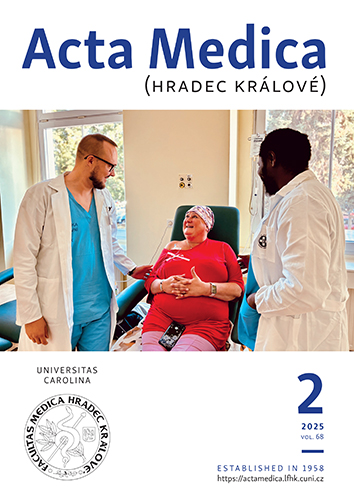ACTA MEDICA, Vol 59 No 2 (2016), 50–53
Improvement of Anaemia in Patients with Primary Myelofibrosis by Low-Dose Thalidomide and Prednisone
Petra Bělohlávková, Vladimír Maisnar, Jaroslava Voglová, Tomáš Buchler, Pavel Žák
DOI: https://doi.org/10.14712/18059694.2016.89
published online: 10. 08. 2016
abstract
Background: A combination of low-dose thalidomide and corticosteroids is a treatment option for anaemic patients with primary myelofibrosis (PMF) who are not eligible for allogeneic hematopoietic stem cell transplantation. Methods: We describe the outcomes of 13 patients with PMF treated with thalidomide 50 mg daily in combination with prednisone 0.5 mg/kg daily. Treatment responses were seen in 10/13 (77%) patients with a median onset of therapeutic effect at 4 weeks (range 3–7 weeks) after treatment initiation. Improvements of anaemia and thrombocytopenia and reduction in splenomegaly were observed in 70%, 38%, and 30% of patients, respectively. Four of six initially transfusion-dependent patients became transfusion independent following the therapy. The median duration of treatment response was 18 months (range 3–35 months). The treatment was well tolerated, with only one patient discontinuing therapy due to toxicity. Responders included both patients with and without JAK2 V617F, and included patients with both newly diagnosed and longstanding PMF. Conclusions: Our retrospective analysis confirmed that the therapy with low-doses thalidomide with prednisone in patients with PMF achieves significant response rate in anaemia with low treatment toxicity.
keywords: Primary myelofibrosis; Immunomodulatory agents; Thalidomide; Treatment

Improvement of Anaemia in Patients with Primary Myelofibrosis by Low-Dose Thalidomide and Prednisone is licensed under a Creative Commons Attribution 4.0 International License.
210 x 297 mm
periodicity: 4 x per year
print price: 150 czk
ISSN: 1211-4286
E-ISSN: 1805-9694
